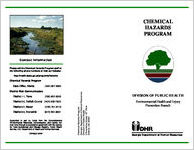Contact Information
Please call the Chemical Hazards Program staff at the following phone numbers or visit our website:
http://health.state.ga.us/programs/hazards
Chemical Hazards Program
State Office, Atlanta
(404) 657-6534
District Risk Communicators
District 1-1, Rome
(706) 802-5343
District 3-5, DeKalb County (404) 508-7900
District 5-2, Macon
(478) 751-6113
District 9-3, Brunswick
(912) 264-3931
Supported in part by funds from the Comprehensive Environmental Response, Compensation, and Liability Act trust fund through a cooperative agreement with the Agency for Toxic Substances and Disease Registry, Public Health Service, U.S. Department of Health and Human Services.
DPH03.016HW
Chemical Hazards Program Georgia Department of Human Resources Division of Public Health 2 Peachtree Street, 16th Floor Atlanta, GA 30303
CHEMICAL HAZARDS PROGRAM
DIVISION OF PUBLIC HEALTH Environmental Health and Injury Prevention Branch
Georgia Department of Human Resources
What is the Chemical Hazards Program?
The Chemical Hazards Program is part of the Environmental Health Section of the Georgia Division of Public Health. It was established in 1994 through a cooperative agreement with the Agency for Toxic Substances and Disease Registry (ATSDR), of the U.S. Public Health Service, to conduct public health investigations at hazardous waste sites in Georgia. Since then, the Chemical Hazards Program has expanded to address all issues and concerns associated with human exposure to toxic chemicals in the environment.
What is the mission of the Chemical Hazards Program?
The mission of the Chemical Hazards Program is to protect the health and promote the quality of life of Georgians through the prevention of exposure to toxic chemicals in the environment.
What are the goals of the Chemical Hazards Program?
The goals of the Chemical Hazards Program are to identify people at risk for health problems from exposure to toxic chemicals in the environment, determine relationships between exposure to toxic chemicals and human diseases, and to reduce or eliminate exposures of health concern.
What services are provided by the Chemical Hazards Program?
To carry out its goals and to serve the needs of the public, the Chemical Hazards Program conducts activities in several areas:
Public Health Assessments Health Consultations Health Studies Technical Assistance Community Education Training Capacity/Coalition Building
Public Health Assessments (PHA) evaluate data and information on the release of toxic chemicals into the environment to assess all past, current or future impacts on public health.
Health Consultations are similar to PHAs, but they usually discuss one specific, site-related public health question.
Health Studies involve conducting investigations, surveillance, and analytical epidemiologic studies that evaluate exposed persons, and identify the relationship between exposure and adverse health outcomes.
Technical Assistance provides written or oral responses to requests for specific information, usually as a review of and/or comment on regulatory agency documents or data.
Community Education addresses the concerns of residents about the health effects from exposure to chemicals in the environment. Education is provided through presentations, public meetings, publications, and the website.
Training enhances environmental health risk communication resources by training district and local health department staff on how toxic substances in the environment may affect human health, and how to communicate the risk of actual or potential exposure.
Capacity/Coalition Building involves responding to requests from other agencies to gather, review, and evaluate data, interpret exposure pathways, determine the health implications of exposure, define risk groups, and address community concerns.
